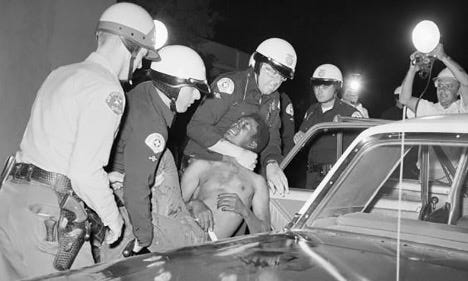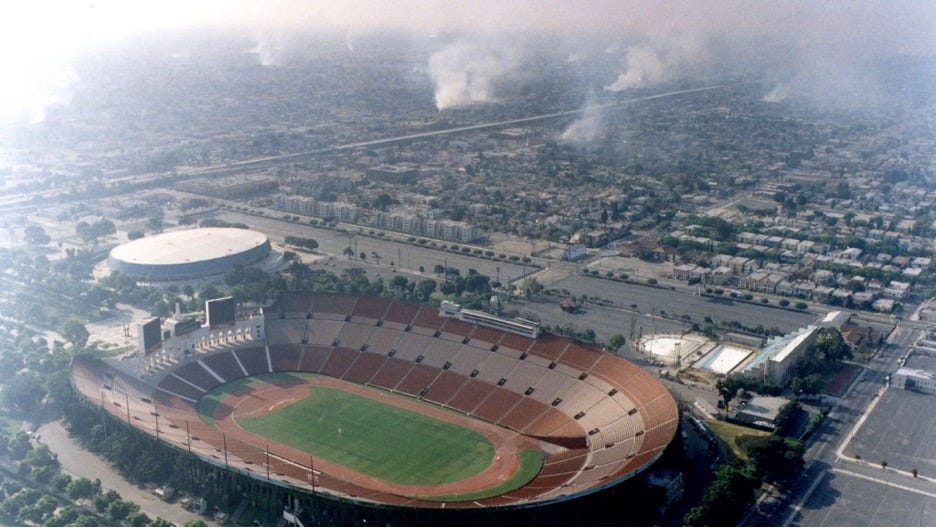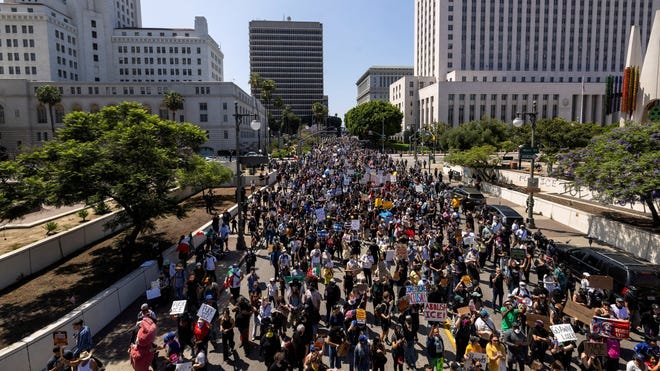What Brian Wilson, the National Guard, and L.A. Tell Us About The Future of Where
Los Angeles is not the same city it was 60 years ago, when "California Girls" met the Watts riots. But we need to embrace the change, not demonize it.
Thanks so much to all of our readers for conitnuing to stick with us at The Future of Where. We are able to keep going because of your support — especially the support of paid subscribers. Please consider becoming a free or paid subscriber today so we can continue delivering great content.
In one of those ironic juxtapositions that you see so often in Los Angeles, Brian Wilson of the Beach Boys, whose songs epitomized the California Dream, passed away last week just as the National Guard was arriving in town to defend federal buildings from supposedly violent protesters.
And as a result, the week has been filled with seemingly unrelated headlines: celebrations of Brian Wilson’s life and his impact on popular culture and Los Angeles’s role in it, and at the same time anxiety and concern about potential clashes in L.A. between protesters and federal troops deployed without the state’s consent.
More than anything else, however, this juxtaposition tells a story of how a city evolves over time – and how people in the same city can live in different worlds.
The Beach Boys historic marker on the site of their childhood home, which was torn down to make way for a freeway that also plowed through nearby African-American neighborhoods.
Obviously, Los Angeles is not the same city that it was 60 years ago when Wilson wrote all those songs celebrating California beach culture. It’s not even the same city it was 30 years ago when I wrote The Reluctant Metropolis, my book about the growth wars in L.A. in the ‘80s and ‘90s. It’s much more urban and gritty, more demographically diverse, and in many ways more economically challenged. It’s a more mature city, at last facing the issues that most large cities face.
So the Los Angeles of Brian Wilson and the Beach Boys – which, in many ways, is the city that beckoned me all those years ago – seems far away. When I was about 9, I sat for hours in my big brother’s second-floor bedroom in a cold, dark Upstate New York and played his 45s. The ones I liked best were the catchy surf songs from the Beach Boys. I didn’t realize it at the time, but there is no doubt in my mind that this planted in my head the idea of someday pursuing the California dream – which I did by moving to L.A., writing a book about the city, and serving as the mayor of a surf town (of course).
The Onetime National Suburb
It is hard to remember now, but in those days Los Angeles was often called “the national suburb” – a place where people from all over the United States moved to pursue a middle-class lifestyle with a house, a car, and a solid job, often in the aerospace industry.
And the Beach Boys were very much products of this era in L.A. history. Murry Wilson, the tyrannical father of the Wilsons and manager of the band, came with his family to L.A. from Kansas as a young boy in the 1920s; they pitched a tent and slept on the beach until they found a permanent place to life. Over time, the Wilsons built a life in what, decades later, Reyner Banham called “The Plains Of Id” – the flatlands of L.A. where working-class folks were able to buy a house and aspire to something bigger, now tht they were free from the constraints they experienced back home in Oklahoma, Kansas, Texas, or wherever they were from.
As a classic father on The Plains of Id, Murry Wilson was a machinist who aspired to be a songwriter. The family lived in first in Inglewood, where today the Rams and Chargers play in Sofi Stadium, and later in Hawthorne, a mile from where Elon Musk’s boring test tunnel now sits. Murry did achieve some success, publishing more than 50 compositions, and encouraging his three boys and their friends and relatives to take up music as well.
This was, of course, during California’s postwar boom years, where everyone seemed to be upwardly mobile and optimism was as ubiquitous as sunshine. And in retrospect it’s fair to say that “peak post-war California dream” was July of 1965, the month that the quintessential Beach Boys song, California Girls, was released.
Because one month later, in August, the Watts riots broke out, when the Los Angeles Police Department’s arrest and subsequent beating of a young black man accused of drunk driving touched off a major civil disturbance in South Central Los Angeles, that vast expanse of historically African-American communities adjacent to the Plains of Id. More than 30 people were killed. It was the first time the nation – and, indeed, many people in Los Angeles itself – understood that the California Dream had not extended to everyone, especially Blacks in South-Central and Mexican-Americans on the east side of L.A.
Although for Blacks L.A. was not as viciously racist as the South, it was deeply segregated and South-Central was largely cut off from the rest of the city; at the time, the area even had its own separate bus company that did not connect with buses in the white parts of the city. (Probably the best picture of this era in L.A. is painted by Walter Mosely’s Easy Rawlins detective novels, beginning with Devil In A Blue Dress.)
The incident that set off the Watts riots, which shattered the California Dream.
The Watts riots led to a tectonic shift in L.A.’s racial, social, and economic geography. The working-class whites in The Plains of Id fled – usually to Orange County, giving rise to The OC’s reputation as a conservative bastion. Paramount, where protesters gathered last week, was mostly white in the 1960s; today’s it’s 80% Latino. Inglewood, where Brian Wilson was born in 1942, was mostly white up until the Watts riots, then it became a prototypical African-American suburb, though it’s now gentrifying. (The riot also also facilitated a rightward shift nationally; without Pat Brown’s fumbled response, Ronald Reagan might not have been elected governor the following year.)
And it is a great irony that as part of the L.A. massive freeway construction – rightly criticized as ripping through Black neighborhoods and isolating African-American communities – also took the Beach Boys’ childhood home in Hawthorne. It was demolished to make way for the Century Freeway (I-105), the last freeway to be built in the central part of L.A. construction of which was held up for 20 years because of environmental litigation. (There’s now a historic marker on the site of the home, right alongside the south side of the freeway.)
Fighting The Last War
The evolution of Los Angeles that led Donald Trump to call out the National Guard and the Marines has been dramatic indeed. First the Mexican-American population grew rapidly, followed by Central Americans, followed by Asian ethnic groups of all kinds, followed by just about every ethnicity you can image. (L.A. is full of “Little This” and “Little That” neighborhoods.) The 1992 riots, though they erupted as the 1965 Watts riots did as the result of a traffic stop of a black motorist, were a multiracial affair, with fires spreading all across the city and people from all backgrounds involved. More than 60 people were killed.
Fires burn near the L.A. Coliseum during the 1992 riots.
Although immigration both legal and illegal has continued, the cost of housing has skyrocketed (even houses in South-Central can now go for a million bucks). As a result, whites, Blacks, and increasingly recent immigrants as well leave L.A. for Las Vegas, Phoenix, Texas, and other places that are less expensive and seem to have greater opportunity. At least for native-born Americans of all races, Los Angeles is no longer “the national suburb” that people all over the country gravitate to for a better life. That title now rests with the so-called “Charlantingham Corridor” (Charlotte-Atlanta-Birmingham) in the Deep South that both whites and Blacks once fled from to find a better life in California.
Protests in Downtown L.A. this week.
So, as much as anything else, it is this history and evolution that Donald Trump is fighting against in calling out the National Guard and the Marines. The Plains of Id were once filled with Trump’s type of folks: families from the Midwest who had solid working-class jobs, owned their own houses, and not incidentally were pretty racist. But Trump’s folks don’t live in L.A. anymore. They’ve fled to the Inland Empire, Phoenix, Las Vegas, Idaho, Montana.
So Trump can try to crack down on a largely immigrant city in a way that plays well with his base. The risk has been hilariously overblown – not a single person has died and most protests have been peaceful – but Trump and his base want to fight the last war, the one over the Plains of Id, which, of course, they’ve already lost.
But the evolution of a city like Los Angeles usually doesn’t make it worse, just different. New York is a very different city than it was at the time of the bankruptcy crisis 50 years ago – like L.A., a multiracial immigrant city with a very different economic base and, in many ways, a different vibe. (To see what L.A. can learn from New York as it faces a stagnant population, check out my Slate article here.) To be sure, Los Angeles faces enormous challenges, especially economically. Aerospace is long gone and the region’s two most important industries, entertainment and imports, are increasingly threatened.
But the solution to these challenges isn’t to demonize L.A. Rather, the solution is to help L.A. prosper as yet another new era of the city emerges.








I wrote about Latino LA 35 years ago because of politics its changing rapidly. My cousin, tall and light-skinned, sells baseball cards at the Santa Fe Springs Swap Meet. Recently, he got caught in an ICE raid. Like thugs, they entered the market, stopped him, and began questioning him.
He had his driver’s license on his phone, but they didn’t want to see it. Instead, one agent started grilling him: Where were you born? Where did you grow up? What school did you go to? while the other just stood there, staring him down.
They were ready to take him “to clear him,” but at the last moment, one of them changed his mind and let him go.
Certianly the solution isn't to demonoze any large group of people or place. But support for actually enforcing immigration law isn't necessarelly based on demonization, though it can be. I concur with much of the writing of the Substack "The Liberal Patriot" (Evan though I wouldn't discribe myself that way) that the majority of progressive Democrats remain rather clueless on average on not only immigration but on many other cultural issues IMHO. And one example of that is that immigration is not just a cultural issue, but also very much a soceoeconomic one as well, something that many Democrats are loath to face.
While some of ICE's actions are clearly unlawfull (this is true with other policing as well to an extent), and racism is law enforcement remains an issue, most of what is being protested is actual enforcement of US immigration law. But many US progessives today are appaled by that barring a huge increase in legal immigration which has not been forthcoming. Nor does most of the public as a whole want such an increase either. Let that part sink in. I think this devide is in part because so many proffesional class Dems now have so little to do with either Trump supporters of any sort or with working class whites in general, because of where they live. And they have increasimgly used immigration as a buffer to push those groups they feel most uncomfortable with away.
What I believe most Trump supporters (I have personally not voted for a major party candidate for US president since Bill Clinton, whom I would not support today, in 1996) actually want is simply to stop the US as a whole from turning into something like Southern California and to preserve their own way of life, which they feel continued mass immigration (among other things) has already damaged and displaced, and threatans to ultimately destroy. There is good indication that such support is actually based on more soceoeconomic and not just cultural or racial fears. And it is also anger that president Biden let in an unprecidented number of people with temporary (if any) legal status in such a short time, and seemed to be outright vindictive to his political apponnants in his aproach, as well as sanctuary city's and other percieved lawlessness and lack of concern for ordenary evoters.
This situation now creates a huge problem for Trump who has (the oppocite of Biden) largely suceeded already in closing the US border to illegal entry but not in actually deporting people in large numbers. It also pads Democratic voting Congressional districts that would otherwise be loosing population (some are anyway).
So far this is frankly a battle that supporters of less immigration have NOT yet lost at the national level, but many are willing to fight for it even at a very high cost, as it is seen as an existencial matter. Most actually are not obsessed about when the US will cease to have a white majority but do want to preserve their own (less diverse and more traditional) way of life to some significant extent. Trump is a corrupt Bilionare who is now old, so I sure wouldn't count on him for much of anything, but he is still seen as at least better by his supporters then the main alternatives. Unfortionately not just for them but for us all, the further developement of A.I (not to mention potential nuclear conflict!) potentially threatens the entire future of human civilization, even while promisimg to elivate it... but that is another (rather scary!) issue of it's own.
However, the race obsession was not only yester-years battle, but one that most of the younger (conservative) generation frankly wishes had never been fought in those terms in the first place. Ultimatally, immigration is a policy choice and there is nothing enevitable about it's nature. Pretending that this consern can just be brushed aside as mere racism or somehow crushed is I believe an enormous mistake for Democrats or anyone to be making, though one that at this point I'm not sure that they can easily get out of. So is relying so heavely on not only overseas but also immigrant labor in the first place. It is not close to being sustainable.
The above is just one reason why, while I am broadly liberal and even somewhat left leaning on many issues including on various aspects of immigration policy, I am decidedly not a progressive and also no longer a member of either major US political party. End rant.